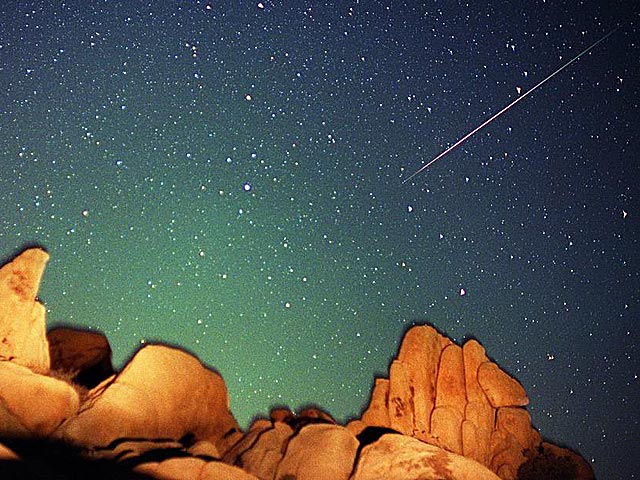Credit & Copyright: Wally Pacholka (Astropics)
Explanation:
The ongoing
Perseid Meteor Shower should be at its strongest
tonight and tomorrow night.
Although meteors should be visible all night long,
the best time to watch will be between 2:00 AM and
dawn each night.
In dark, moonless, predawn
skies you may see dozens of meteors per hour.
Sky enthusiasts in Europe and
Asia might see an unusual burst of meteors near 2100 hours
UT.
Grains of cosmic sand and gravel shed from
Comet Swift-Tuttle will
streak across the sky as they vaporize during entry into Earth's atmosphere.
Tracing the meteor trails backwards,
experienced skygazers will find they converge
on the constellation Perseus, thus this
annual meteor shower's name.
Pictured
above is a Perseid meteor from 2002 over a rock formation in
the US Southwest desert.
Shadowing and blurring are caused by the long 10-minute exposure.
The brightest Perseids can be seen from anywhere on Earth
by monitoring the continuously returning images from the
Night Sky Live
cameras.
1999 2000 2001 2002 2003 2004 2005 2006 2007 2008 2009 2010 2011 2012 2013 2014 2015 2016 2017 2018 2019 2020 2021 2022 2023 2024 2025 |
Январь Февраль Март Апрель Май Июнь Июль Август Сентябрь Октябрь Ноябрь Декабрь |
NASA Web Site Statements, Warnings, and Disclaimers
NASA Official: Jay Norris. Specific rights apply.
A service of: LHEA at NASA / GSFC
& Michigan Tech. U.
|
Публикации с ключевыми словами:
Perseids - meteor shower - Персеиды - метеорный дождь
Публикации со словами: Perseids - meteor shower - Персеиды - метеорный дождь | |
См. также:
Все публикации на ту же тему >> | |
